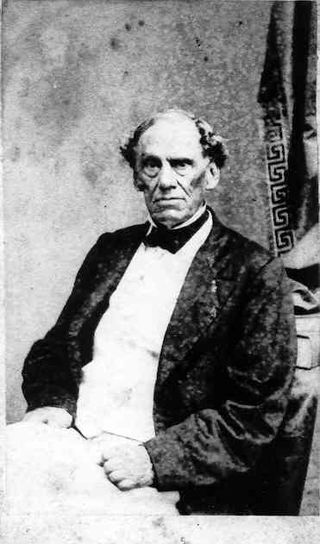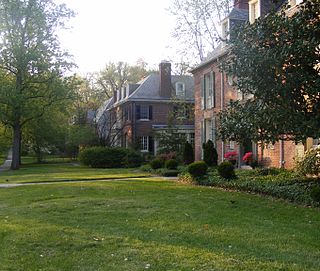
Yancey County is a county located in the U.S. state of North Carolina. As of the 2020 census, the population was 18,470. Its county seat is Burnsville.

McDowell County is a county located in the U.S. state of North Carolina. As of the 2020 census, the population was 44,578. Its county seat is Marion.

Yanceyville is a town in and the county seat of Caswell County, North Carolina, United States. Located in the Piedmont Triad region of the state, the town had a population of 1,937 at the 2020 census. The town was established in 1791 as Caswell Court House and was renamed Yanceyville in honor of U.S. Congressman Bartlett Yancey, Jr. when it was chartered as an incorporated town in 1833.

Burnsville is a town that serves as the county seat of Yancey County, North Carolina, United States. Located in the Blue Ridge Mountains of western North Carolina, sits in the shadow of Mount Mitchell, the highest peak in the Eastern Continental United States. The population was 1,612 at the 2020 census.

Bedford Brown was a Democratic United States Senator from the State of North Carolina between 1829 and 1840.

The Smith-McDowell House is a c. 1840 brick mansion located in Asheville, North Carolina. It is one of the "finest antebellum buildings in Western North Carolina." Listed on the National Register of Historic Places, it was the first mansion built in Asheville and is the oldest surviving brick structure in Buncombe County. Since October, 2023, the building is home to Asheville Museum of History.

The Blount Mansion, also known as William Blount Mansion, located at 200 West Hill Avenue in downtown Knoxville, Tennessee, was the home of the only territorial governor of the Southwest Territory, William Blount (1749–1800). Blount, a Founding Father of the United States, a signer of the United States Constitution, and a U.S. Senator from Tennessee, lived on the property with his family and ten African-American slaves. The mansion served as the de facto capitol of the Southwest Territory. In 1796, much of the Tennessee Constitution was drafted in Governor Blount's office at the mansion. Tennessee state historian John Trotwood Moore once called Blount Mansion "the most important historical spot in Tennessee."
The Parkway Playhouse, located in Burnsville, North Carolina, is the oldest continually operating summer theater in North Carolina.

Guilford is a historic neighborhood in the northern part of Baltimore, Maryland.

Heritage Square is a place in Fayetteville, North Carolina. Owned and maintained by The Woman's Club of Fayetteville, Heritage Square includes the Sandford House, built in 1797; the Oval Ballroom, a freestanding single room built in 1818; and the Baker-Haigh-Nimocks House, constructed in 1804. The buildings located on Heritage Square are listed in the National Register of Historic Places as the "Fayetteville Woman's Club and Oval Ballroom" and "Nimocks House."

The Carson House is a historic house and museum located in Marion, North Carolina. It was the home of Col. John Hazzard Carson, and served as the McDowell County courthouse when the county was first organized in 1842.

The Nu Wray Inn is an historic hotel located at Burnsville, Yancey County, North Carolina. It was built in 1833 at the time Yancey County was formed and a year before Burnsville was established. It was originally built of logs and had eight bedrooms and a dining room and kitchen. It was listed on the National Register of Historic Places in 1982.

The House in the Horseshoe, also known as the Alston House, is a historic house in Glendon, North Carolina in Moore County, and a historic site managed by the North Carolina Department of Natural and Cultural Resources' Historic Sites division. The home, built in 1772 by Philip Alston, was the site of a battle between loyalists under the command of David Fanning and patriot militiamen under Alston's command on either July 29 or August 5, 1781. The battle ended with Alston's surrender to Fanning, in which Alston's wife negotiated the terms with the loyalists.

Washington Magnet Elementary School is a historic school and building located at Raleigh, Wake County, North Carolina. It was built in 1923-1924 to serve African-American students in Raleigh and is now a magnet elementary school.

Yancey County Courthouse is a historic courthouse located at Burnsville, Yancey County, North Carolina. It was built in 1908, and is a two-story, Classical Revival style, stuccoed concrete block building faced in stucco. It has a central pedimented entrance pavilion surmounted by a blocky cupola. It features Corinthian order pilasters and polygonal corner projections. The building housed county offices until 1965, when a new courthouse was constructed.

Citizens Bank Building, also known as the Yancey County Public Library Building, is a historic bank building located at Burnsville, Yancey County, North Carolina. It was built in 1925, and is a three-story, yellow brick Renaissance Revival-style building. The front facade features fluted Corinthian order pilasters and arched brick openings. The building housed a bank until 1972, when it was donated for use as a county library.
Chase-Coletta House, also known as the Lillie Ray Chase House, is a historic home located on the town square of Burnsville, Yancey County, North Carolina. It was built in 1914–1915, and is a 1+1⁄2-story, rectangular, Bungalow / American Craftsman style frame dwelling. It sits on a brick foundation and is sheathed in weatherboard. It features large gable dormers, a sleeping porch, and a hip roofed wraparound porch on brick piers. Also on the property is a contributing shed.

Yancey Collegiate Institute Historic District is a historic school complex and national historic district located at Burnsville, Yancey County, North Carolina. The district encompasses seven contributing buildings, one contributing structure, and one contributing object built between 1914 and 1955. Contributing resources include the Brown Dormitory for Boys (1914), (Former) Burnsville High School Gymnasium, an outdoor amphitheater (1950-1952), the Classical Revival style (Second) Administration Building for Yancey Collegiate Institute, Gymnasium, former Burnsville High School built by the Works Progress Administration (1939) and a stone retaining wall. The Yancey Collegiate Institute (YCI) was established in 1901 and sponsored by the Baptist church. The YCI educated students until 1926, when the facilities were sold to the Yancey County Board of Education.
Higgins is a populated place in Egypt Township in Yancey County, North Carolina, United States. Already in decline in the 1920s, it was revived by a Presbyterian missionary who obtained support from the Markle Foundation in the 1930s, but has since been largely abandoned. Under the name of "Henry", it was a case study in Cities and the Wealth of Nations, by Jane Jacobs, who spent six months there in 1934.




















